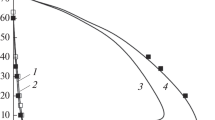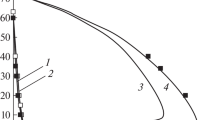Summary
A method is presented for determining the velocity, temperature, and concentration distributions as well as the position of the reaction zone near the surface of a burning fuel. The reaction is assumed to occur in the compressible laminar boundary layer on a flat plate. Variations in properties are allowed for subject to the requirements that the Prandtl and Schmidt numbers equal one and the density-viscosity product is a constant. A method is given for transforming from the boundary layer to the real coordinate system.
Similar content being viewed by others
Abbreviations
- a, b :
-
stoichiometric coefficients
- a 1, a 2, b 1, b 2 :
-
constants
- B :
-
transfer parameter, dimensionless
- c :
-
concentration parameter, dimensionless
- C :
-
concentration, g component/g mixture
- C P :
-
specific heat at constant pressure, cal/g°C
- D :
-
diffusivity, cm2/s
- f :
-
velocity boundary layer parameter, dimensionless
- h :
-
enthalpy parameter, dimensionless
- H :
-
specific enthalpy, cal/g or ergs/g
- ΔH :
-
heat of reaction, cal/g oxidant (B)
- \(\bar H\) :
-
partial specific enthalpy. cal/g or ergs/g
- J :
-
mass flux, g/cm2/s
- k :
-
thermal conductivity, cal/cms°C
- p :
-
pressure, dynes/cm2
- P :
-
Prandtl number, dimensionless
- Q :
-
heat loss, cal/g fuel (A) evaporating
- S :
-
Schmidt number, dimensionless
- t :
-
time, s
- T :
-
temperature, °C
- u :
-
velocity in x direction, dimensionless
- U :
-
velocity in x direction, cm/s
- v :
-
velocity in y direction, dimensionless
- V :
-
velocity in y direction, cm/s
- x :
-
direction parallel to plate, cm
- y :
-
direction perpendicular to plate, cm
- η :
-
boundary layer coordinate, dimensionless
- λ :
-
heat of vaporization, cal/g
- μ :
-
viscosity, g/cms
- ν :
-
kinematic viscosity, cm2/s
- ρ :
-
density, g/cm3
- A :
-
fuel or surface side of reaction zone
- B :
-
oxidant or mainstream side of reaction zone
- C :
-
concentration
- i :
-
species i
- M :
-
mainstream conditions
- R :
-
reaction zone conditions
- S :
-
surface conditions
- T :
-
thermal
References
Friedlander, S. K. and Mitchell Litt, Chem. Eng. Sci. 7 (1958) 229.
Spalding, D. B., The Combustion of Liquid Fuels, Fourth Symposium (International) on Combustion, Williams and Wilkins, Balto., 1953, p. 847.
Emmons, H. W., Z. angew. Math. Mech. 36 (1956) 60.
Bird, R. B., Theory of Diffusion, Advances in Chemical Engineering, edited by T. B. Drew and J. W. Hoopes Jr., Academic Press, New York, 1956.
Chapman, S. and T. G. Cowling, The Mathematical Theory of Non-Uniform Gases, 2nd ed., Cambridge University Press, 1953, Ch. 14.
Chapman, D. and M. Rubesin, J. Aero. Sci. 16 (1949) 547.
Schlichting, H., Boundary Layer Theory, McGraw-Hill, New York, 1955, p. 235.
Mickley, H. S., R. C. Ross, A. L. Squyers and W. E. Stewart, N.A.C.A. Tech. Note 3208, Washington, July 1954.
Author information
Authors and Affiliations
Rights and permissions
About this article
Cite this article
Friedlander, S.K., Litt, M. Rapid chemical reaction in a laminar boundary layer. Appl. sci. Res. 8, 403–412 (1959). https://doi.org/10.1007/BF00411766
Received:
Issue Date:
DOI: https://doi.org/10.1007/BF00411766




